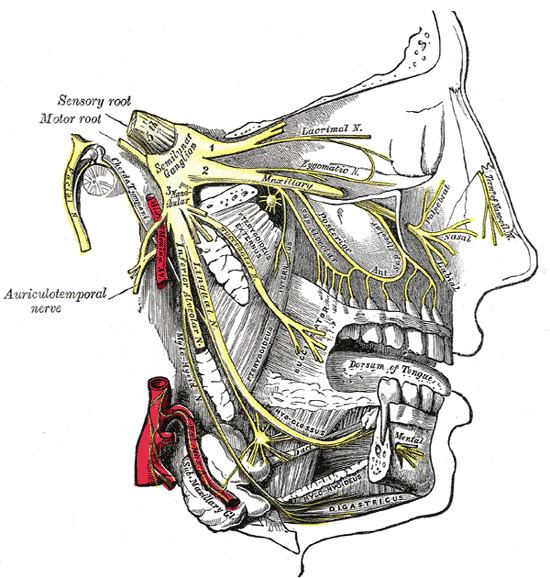Dorlands/Elsevier n_05/12565154 | Innervates dental alveolus TA A14.2.01.089 | |
 | ||
Latin nervus alveolaris inferior | ||
The inferior alveolar nerve (sometimes called the inferior dental nerve) is a branch of the mandibular nerve, which is itself the third branch (V3) of the trigeminal nerve (cranial nerve V).
Contents
Structure
The inferior alveolar nerve is a branch of the mandibular nerve. After branching from the mandibular nerve, the inferior alveolar nerve travels behind the lateral pterygoid muscle. It gives off a branch, the mylohyoid nerve, and then enters the mandibular foramen.
While in the mandibular canal within the mandible, it supplies the mandibular (lower) teeth (molars and second premolar) with sensory branches that form into the inferior dental plexus and give off small gingival and dental nerves to the teeth.
Anteriorly, the nerve gives off the mental nerve at about the level of the mandibular 2nd premolars, which exits the mandible via the mental foramen (supplying sensory branches to the chin and lower lip).
The inferior alveolar nerve continues anteriorly as the mandibular incisive nerve to innervate the mandibular canines and incisors.
Function
The inferior alveolar nerves supply sensation to the lower teeth.
The mylohyoid nerve is a motor nerve supplying the mylohyoid and the anterior belly of the digastric.
Injury
Inferior nerve injury most commonly occurs during surgery including wisdom tooth, dental implant placement in the mandible, root canal treatment where tooth roots are close to the nerve canal in the mandible, deep dental local anaesthetic injections or orthognathic surgery. Trauma and related mandibular fractures are also often related to inferior alveolar nerve injuries.
Trigeminal sensory nerve injuries are associated with numbness, pain, altered sensation and usually a combination of all three. This can result in a significant reduction in quality of life for the patient with functional difficulties and psychological impact
The risk associated with wisdom tooth surgery is commonly accepted to be 2% temporary and 0.2% permanent. However, this risk assessment is not concrete as the same sourceis cited for lingual nerve paresthesia. It is well documented that inferior alveolar nerve injury is more common than lingual nerve injury. The percentage of injury varies significantly in different studies. Furthermore, many factors affect the incidence of nerve injury. For example, the indicience of nerve injury in teens removing third molars is much lower than the incidence in patients 25 and older. This risk increases 10 fold if the tooth is close to the inferior dental canal containing the inferior alveolar nerve (as judged on a dental radiograph). These high risk wisdom teeth can be further assessed using cone beam CT imaging to assess and plan surgery to minimise nerve injury by careful extraction or undertaking a coronectomy procedure in healthy patients with healthy teeth
The risk of nerve injury in relation to mandibular dental implants is not known but it is a recognised risk requiring the patient to be warned. If an injury occurs urgent treatment is required.
The risk nerve injury in relation deep dental injections has a risk of injury in approximately 1:14,000 with 25% of these remaining persistent. Avoiding inferior alveolar nerve injuries is possible. Ask your dentist about using infiltration dentistry (avoiding deep injections) Routine preoperative warnings about these injuries is routinely undertaken in the US and Germany. This reflects good practice recommended by the Royal College of Anaesthetists (prior warning of potential nerve injury in relation to spinal and epidural blocks 1 on 24-57,000 risk) and NHS patient.uk.com.
Anesthesia
Administration of anesthesia near the mandibular foramen causes blockage of the inferior alveolar nerve and the nearby lingual nerve (supplying the tongue). This is why the numbing of the lower jaw during dental procedures causes patients to lose sensation in:
